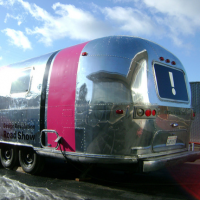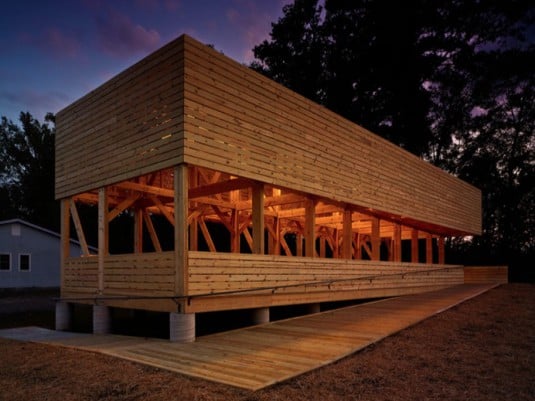
May 14, 2012
To the New Grads at UC Berkeley
This past Sunday evening Emily Pilloton delivered the commencement address at the College of Environmental Design at UC Berkeley, her alma mater. Here is a lightly edited version of her inspirational talk that can apply to everyone in the design field today, not just to new grads, as well as to anyone seeking to put […]
This past Sunday evening Emily Pilloton delivered the commencement address at the College of Environmental Design at UC Berkeley, her alma mater. Here is a lightly edited version of her inspirational talk that can apply to everyone in the design field today, not just to new grads, as well as to anyone seeking to put meaning in what they do all day.–SSS
I feel fairly unqualified to be your graduation speaker: I was not a great student during my time here. I am not really a good “adult,” either, as I have no savings account or long-term health insurance. Also, I am not primarily interested in addressing you as architects and designers this evening, but first and foremost as citizens, and only then, as members of a professional community.
So with those disclaimers in mind, I want to share two stories with you. They are not stories of success so much as adventure. Take them as cautionary tales or advice or just stories of a girl who, like you, graduated from this institution and is still trying to find the best modes of operation in design and in life.
First story: Almost five years ago, I quit a corporate retail design job, selecting paint colors and doorknobs, moved in with my parents, and started a nonprofit design agency with no business plan and $1,000 in my bank account. Many people called this impulsive.
I started Project H Design out of frustration: I wanted design to matter. Yes, I wanted to contribute something with my skills, but I also wanted to be challenged. I wanted to push myself and push design to have to grapple with the complexity of reality: of real people, real places, and real problems. I stood in the Secretary of State’s office on January 8, 2008, holding my incorporation documents in my hand, with no business savvy, just a mission statement; no slush fund, just my own checking account. And yet, from impulsiveness, we can learn the importance of starting.
Having put that stake in the ground, in legal corporate form, I was forced to figure it out. In our first two years, Project H completed over dozen projects in six countries, I wrote a book about humanitarian design, got in an Airstream trailer and drove to 35 cities in 75 days on a Design Revolution Road Show, and picked up a border collie puppy as an impulse buy in Texas along the way. What some call impulse, others call initiative. Ideas are worth little without action. The best way to start is simply to start.
I said these exact words to a design student I met in Detroit, who was working on a project with the homeless population. She asked me, “What’s the best way to get started, to make this a real enterprise and not just a school project?” I gave her the stupidly simple answer: “The best way to start is to simply start.” Now, two years later, her organization, The Empowerment Plan,
is thriving. She has a viable financial plan, a manufacturing facility, and employed numerous homeless individuals using design as the vehicle. She recently sent me an email to thank me for my advice. But I can take no credit. The bravery is all hers: the hardest, but always the most important thing to do, is simply to start.
Second story: In 2009, my Project H partner, Matthew Miller, and I, uprooted the organization from its headquarters in San Francisco (aka our apartment), and moved to a town of 2,000 in the deep South and became high school shop teachers. Most people, including my own grandmother, called this crazy.
We moved to Bertie County, in the impoverished and uber-rural northeastern part of North Carolina, the land of tobacco, cotton, poisonous snakes, and some heartbreaking remnants of slavery-era racism, on the invitation of the visionary public school superintendent. He believed in design, and asked us to help prove that creativity could be a path to progress, in a community with a severe allergy to change.
Over the past three years, Matt and I have gone deep, designing and building new computer labs, a weight room for the football team, plastering countywide graphic campaigns on the sides of buildings, and most importantly, becoming teachers ourselves. Our curriculum, Studio H, teaches high school juniors creativity, critical thinking, citizenship, and construction skills to equip them as job- and college-ready individuals. They do this as part of their school day, earning high school and college credit, and a working wage during on-site construction.
Our Studio H students have designed and built three public chicken coops, a 2,000-square-foot farmers market pavilion for their hometown of Windsor (they also started the market as a local enterprise), and two smaller iconic farm stands that double as community bulletin boards. Matt and I may be trained as architects and designers, but in Bertie County, we also tutored students in pre-calculus, became licensed school bus drivers, rescued stray hunting dogs, fought with the school board, wrote college recommendation letters, ran marathons, organized events with the mayor, attended Rotary club meetings, and accidentally started saying y’all. We take little credit for what our students have built: it was their vision for their hometown. They were given the key to the city for building the farmers market, many are the first in their families to graduate high school or go to college, and they are leaders of their own community.

At the opening ceremony for the farmers market, one of our students said to the mayor, “I hope to bring my kids back here someday and tell them that I built this.” And later he turned and said to us, “Studio H made me see the world, and myself, differently, and I will never be the same.”
Many called this move to the Deep South crazy. We definitely found it uncomfortable as we were pushed to our physical and emotional limits. But from discomfort, we learn that we can only to know the richness of life through active experience.
One of the quotes we love most is from a chapter of Thoreau’s Walden:
“I wanted to live deep and suck out all the marrow of life…to cut a broad swath and shave close, to drive life into a corner… and, if it proved to be mean, why then to get the whole and genuine meanness of it; or if it were sublime, to know it by experience.”
We cannot merely talk, we must do. Matthew B. Crawford, who wrote the fantastic book Shopclass as Soulcraft, describes this as not merely knowing that, but knowing how (for example not only teaching our students that the weight of concrete is about 150 pounds per cubic foot, but more importantly how to design, engineer, and pour a concrete foundation footer). It is not merely enough to be well read, to know the facts, and to be able to recount them from a conference podium. We must know how to do things, and the only way to learn how, is to do.
Do something with all you have learned–something for others, something for your family, for the planet, for fun, for love. Just do something. Seek not the glory but the task, not the limelight, but the sunlight. Do not sit idle or live your life through a screen. Stop tweeting and start contributing. With our high school students, we ban the use of two phrases: “I’m bored,” and “I’m done.” You, too, must be never be either.
Despite the seeming misguidance of each of these two moments, they are somehow the proudest of my life (in hindsight, of course). The irresponsible, impulsive, and uncomfortable teach us how to be optimistically disobedient, how to start against all odds, and how to be present and go deep in the world. My hope for each of you is that you seek out and find yourself in similarly irresponsible, impulsive, and uncomfortable situations that solidify your strength of mind and hand as a citizen and as a designer.
Of course, you are graduating into a professional community that is currently facing some challenges: some say growing pains; some say identity crisis. Don’t freak out, but architecture boasts the highest unemployment rate of any industry–you may have seen the recent article that broadcasted this fact. And many of us find ourselves in a crisis of conscience, seeking to shift our role as bearers of a privilege for the 1%, to couriers of a creative resource for everyone.
The good news is that as architects and designers, it is in our fabric to believe in possibility and in building a better future, so in the challenges of our changing profession, we should see only a context in which to find new solutions, to trade in new currencies, and to rewrite our own job descriptions. With our skill sets, what else can we do? Where can we contribute? Can we carry our toolboxes into unexpected roles, architects disguised as high school teachers, public policy makers, and strategists, where creative thinking would be an untapped resource? The thing that will ground us and help us define the next phase of our profession is our citizenship, both personal and collective, and this is why I believe it is the only place to start.
My stories lend two lessons: Start now. Know life through experience. We as architects, designers, builders, are particularly equipped to do these two things. We are both the offenders of culture and the defenders of culture. Environmental design is both an expression of community and a source community. If what we do, at its core, is build responses to context, then we are uniquely poised to be change makers: We build beautiful, crazy, functional physical solutions, and we do it with optimism in the context of the here and now. Start now. Know life through experience.
When we talk about change, we often circle back to the well-known Gandhi quote: “Be the change you wish to see in the world.” I hope we can do him one better: Let’s build the change we wish to see. Thank you very much.
Emily Pilloton is the founder and executive director of Project H and the author of Design Revolution: 100 Products that Empower People (a Metropolis Book).
Various parts of this post was amended to better reflect the speech on Monday May 14, 2012.






